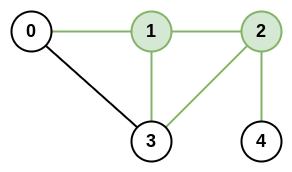
g1601_1700.s1615_maximal_network_rank.readme.md Maven / Gradle / Ivy
Go to download
Show more of this group Show more artifacts with this name
Show all versions of leetcode-in-java Show documentation
Show all versions of leetcode-in-java Show documentation
Java-based LeetCode algorithm problem solutions, regularly updated
The newest version!
1615\. Maximal Network Rank
Medium
There is an infrastructure of `n` cities with some number of `roads` connecting these cities. Each roads[i] = [ai, bi] indicates that there is a bidirectional road between cities ai and bi.
The **network rank** of **two different cities** is defined as the total number of **directly** connected roads to **either** city. If a road is directly connected to both cities, it is only counted **once**.
The **maximal network rank** of the infrastructure is the **maximum network rank** of all pairs of different cities.
Given the integer `n` and the array `roads`, return _the **maximal network rank** of the entire infrastructure_.
**Example 1:**
****
**Input:** n = 4, roads = [[0,1],[0,3],[1,2],[1,3]]
**Output:** 4
**Explanation:** The network rank of cities 0 and 1 is 4 as there are 4 roads that are connected to either 0 or 1. The road between 0 and 1 is only counted once.
**Example 2:**
****
**Input:** n = 5, roads = [[0,1],[0,3],[1,2],[1,3],[2,3],[2,4]]
**Output:** 5
**Explanation:** There are 5 roads that are connected to cities 1 or 2.
**Example 3:**
**Input:** n = 8, roads = [[0,1],[1,2],[2,3],[2,4],[5,6],[5,7]]
**Output:** 5
**Explanation:** The network rank of 2 and 5 is 5. Notice that all the cities do not have to be connected.
**Constraints:**
* `2 <= n <= 100`
* `0 <= roads.length <= n * (n - 1) / 2`
* `roads[i].length == 2`
* 0 <= ai, bi <= n-1
* ai != bi
* Each pair of cities has **at most one** road connecting them.© 2015 - 2024 Weber Informatics LLC | Privacy Policy